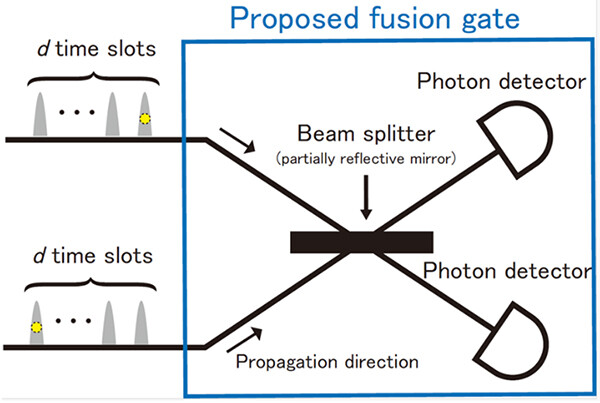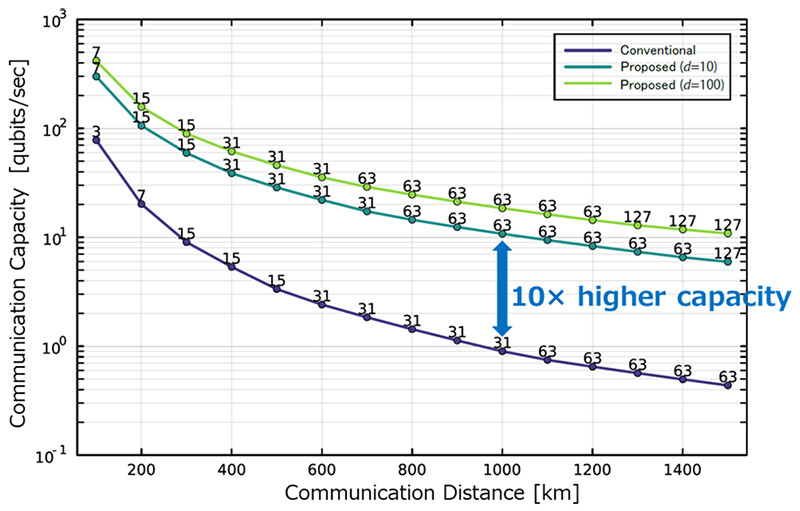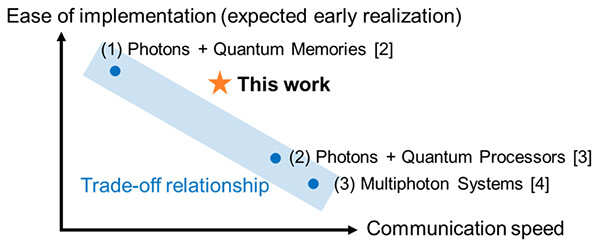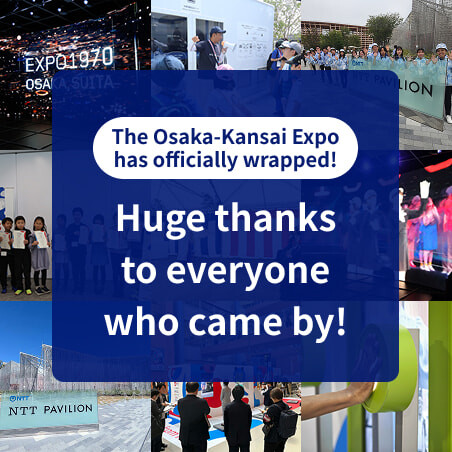Microsoft ends support for Internet Explorer on June 16, 2022.
We recommend using one of the browsers listed below.
- Microsoft Edge(Latest version)
- Mozilla Firefox(Latest version)
- Google Chrome(Latest version)
- Apple Safari(Latest version)
Please contact your browser provider for download and installation instructions.
May 21, 2025
NTT Corporation
Breaking the Theoretical Limit of Photonic Quantum Operation with High-Dimensional "Quantum Dits"
A New Path Toward Earlier Realization of High-Speed, Long-Distance Quantum Communication
News Highlights:
- In photonic quantum information processing, a critical operation known as the "fusion gate" has long faced a major limitation: it can succeed only 50% of the time, posing a significant barrier to practical applications.
- This study theoretically demonstrates that replacing conventional two-level quantum bits (qubits) with higher-dimensional "quantum dits (qudits)" dramatically improves the success rate of fusion gates.
- As an application of this enhanced gate, the researchers proposed a novel long-distance quantum communication protocol and numerically showed that it could achieve nearly an order of magnitude higher data capacity compared to conventional protocols.
TOKYO - May 21, 2025 - NTT Corporation (Headquarters: Chiyoda, Tokyo; President and CEO: Akira Shimada; hereinafter "NTT") has proposed a novel photonic quantum operation using high-dimensional "quantum dits (qudits)," an extension of conventional quantum bits (qubits), and demonstrated that its success rate significantly exceeds the previous theoretical limit.
Qubits realized with photons are crucial to the development of quantum information technologies—such as quantum computing and quantum communication—due to their ability to travel at the speed of light. However, a major challenge has persisted: a key operation known as the "fusion gate," essential for such technologies, has a maximum theoretical success rate of only 50% [1].
In this study, instead of using traditional qubits that can exist in a superposition of two states (0 and 1), the researchers theoretically showed that using qudits—quantum systems capable of existing in superpositions of three or more states—enables the implementation of fusion gates with much higher success rates, surpassing the established theoretical limit.
As a practical application, the researchers proposed a new long-distance quantum communication protocol and numerically demonstrated that it can achieve nearly an order of magnitude higher capacity compared to conventional protocols.
Importantly, the proposed photonic quantum operations can be realized using experimental techniques comparable to currently available ones, suggesting a promising path toward earlier realization of high-speed, long-distance quantum communication.
These results were published in Physical Review Letters on May 20, 2025.
Background
In today's information-driven society, light is indispensable. The same holds true for quantum technologies such as quantum computing and quantum communication, where light is expected to play a central role. One widely used approach to photonic quantum information processing employs photons1—the elementary particles composing light. In this method, quantum information is, for instance, encoded in the timing of single-photon pulses.
One of the most common technique involves using a superposition2 of two distinct arrival timings of a single photon to represent a quantum bit, or qubit (see Figure 1, left). However, it is also possible to consider superpositions of three or more arrival timings, enabling a single photon to carry more quantum information at once (see Figure 1, right). Such quantum states—those that involve a superposition of three or more values—are known as quantum dits (qudits). The number of possible values corresponds to the dimensionality of the quantum state. In this sense, qudits are a high-dimensional extension of qubits.
 Figure 1 Comparison Between a Qubit and a Qudit Using a Single Photon
Figure 1 Comparison Between a Qubit and a Qudit Using a Single Photon
Note. Quantum information is represented by which of several optical pulses—each traveling at different time slots—contains a single photon. In a qubit, this corresponds to a two-dimensional superposition of two possible time slots, typically labeled "0" and "1". In contrast, a qudit represents a higher-dimensional superposition involving three or more time slots, such as "0", "1", "2", and so on.
In quantum information processing using photon-based qubits or qudits, a quantum operation known as the fusion gate3 plays a crucial role. This gate is responsible for "connecting" independently prepared qubits. However, standard fusion gates have a fundamental limitation: even in theory, their success rate is capped at 50% [1]. This low efficiency has been a major bottleneck in realizing large-scale quantum information processing applications, such as quantum computing and long-distance quantum communication4. Furthermore, while replacing qubits with qudits might appear to offer a solution, conventional approaches using qudits have actually resulted in even lower success rates for fusion gates—making the challenge even greater.
Research Results
In this study, the researchers proposed a new type of fusion gate tailored for qudits and theoretically demonstrated that it can achieve a success rate exceeding 50%. Remarkably, this fusion gate can be implemented using techniques equivalent to those used for standard fusion gates (see Figure 2), yet its success rate improves significantly as the dimensionality of the qudits increases—that is, as the number of possible arrival timings of a single photon increases. As a concrete application of the proposed fusion gate, the team introduced a novel long-distance quantum communication protocol and numerically showed that it could achieve nearly an order of magnitude higher data capacity compared to conventional protocols.
 Figure 2 Experimental Setup of the Proposed Fusion Gate
Figure 2 Experimental Setup of the Proposed Fusion Gate
Note. Since the conventional fusion gate corresponds to the proposed fusion gate with a dimension of 2 (= the number of time slots of a photon), the required experimental setup is the same between the conventional method and the proposed method (except that the number of time slots to be identified by the photon detector increases). On the other hand, its success rate increases significantly with the dimension, following 1-1/d. (For example, 75% in 4 dimensions and 90% in 10 dimensions.)
Technical Highlights
The key reason for the high success rate of the proposed fusion gate lies in a novel approach of performing quantum operations across different dimensions. Conventional fusion gates are quantum operations either from qubits to qubits or from qudits to qudits (see Figure 3, left). In contrast, this study explores a fusion gate as a quantum operation from qudits to qubits (see Figure 3, right). While each of the input qudits inherently includes three or more values (i.e., arrival timings of a photon), each of the output qubits just takes two values. These two values are selected from multiple combinations of possible values of the input qudits. This increase in the number of possible output patterns leads to the improvement of the overall success rate in accordance with the dimensionality of input qudits. This represents a novel application of qudits—distinct from their commonly known advantage of transmitting more quantum information at once—and demonstrates their utility in enhancing efficiency of quantum operations.
 Figure 3 Comparison Between Conventional and Proposed Fusion Gates
Figure 3 Comparison Between Conventional and Proposed Fusion Gates
Note. In the proposed fusion gate, the input consists of two qudits—a quantum state in which a single photon can exist in one of three or more time slots (five in this example). At the output stage, two time slots are randomly selected to form a qubit-like state. Regardless of which two slots are chosen, the operation is considered a successful fusion. Therefore, increasing the number of possible time slots (i.e., the dimensionality of the qudits) leads to a higher overall success probability.
Application: Increasing the Capacity of Long-Distance Quantum Communication
A typical way to realize long-distance quantum communication is to use a quantum repeater protocol, which uses repeater nodes placed between the sender and receiver. The protocol begins with short-distance quantum communication to share quantum entanglement5—a genuinely quantum correlation—between neighboring repeater nodes. Then, these shared entangled states are then "connected" at the repeater nodes using a fusion gate, ultimately converted to a long-range entangled state between the sender and receiver. This entangled state enables them to perform quantum communication over long distances. However, for the connection process to succeed, the fusion gate must succeed at every repeater node. If even one of the gates fails, the entire process must be restarted. As a result, the quantum communication capacity—the average amount of entanglement shared per unit time between sender and receiver—is essentially determined by the success rate of the fusion gates.
In this study, the researchers designed a quantum repeater protocol that uses the proposed high-success fusion gate in place of conventional ones. They showed numerically that this new protocol improves the quantum communication capacity by nearly an order of magnitude (see Figure 4). Furthermore, the proposed quantum repeater design is based on the use of realistic quantum memories6, which makes it more feasible for near-term implementation compared to alternative approaches (see Figure 5).
 Figure 4 Comparison of Quantum Communication Capacity versus Distance between Conventional and Proposed Protocols
Figure 4 Comparison of Quantum Communication Capacity versus Distance between Conventional and Proposed Protocols
Note. We compare the quantum communication capacities assuming qudit dimensions of d = 10 and d = 100, with both photon detection efficiency and quantum memory coupling efficiency set at 95%. While increasing the number of repeater nodes reduces the distance between adjacent nodes, it also requires a greater number of successful fusion gates. As a result, there exists an optimal number of repeater nodes that maximizes the communication capacity. The numbers indicated next to each data point represent the optimal number of repeater nodes for maximizing the quantum communication capacity.
 Figure 5 Positioning of the Proposed Long-Distance Quantum Communication Protocol
Figure 5 Positioning of the Proposed Long-Distance Quantum Communication Protocol
Note. Quantum repeater protocols can be broadly classified into three categories. Although some have undergone proof-of-principle demonstrations, none have yet reached the stage of practical implementation. NTT has previously proposed memory-free protocols utilizing a large number of photons—such as the all-photonic quantum repeater7 (corresponding to (3) in the figure)—which enable extremely high-speed quantum communication and represent the ultimate goal for quantum networks. However, the required technological level remains very high, and practical realization is still challenging. On the other hand, memory-based protocols (corresponding to (1)) are considered more feasible due to their relatively lower technical requirements, but their major drawback has been extremely low communication speeds. The protocol proposed in this study falls into the memory-based category, yet overcomes this drawback, enabling high-speed quantum communication while maintaining practical feasibility.
Outlook
The newly proposed fusion gate has the potential to significantly enhance the performance of a wide range of photonic quantum information processing when adopted as a fundamental quantum operation. In particular, the quantum communication protocol proposed as a concrete application of the proposed gate demonstrated an order-of-magnitude improvement in communication speed compared to conventional protocols—overcoming one of their key limitations. This advancement paves the way for earlier realization of long-distance quantum communication, including international and intercontinental links.
As research and development of quantum computers continue worldwide, traditional cyptosystems face increasing risks of being rendered insecure. In this context, the early deployment of quantum communication, which offers security even against arbitrary attacks based on quantum computers, has become a critical societal challenge.
Publication Information
Journal: Physical Review Letters (Online publication date: May 20)
Title: Linear-optical fusion boosted by high-dimensional entanglement
Authors: Tomohiro Yamazaki and Koji Azuma
DOI: https://doi.org/10.1103/PhysRevLett.134.200801
URL: https://journals.aps.org/prl/abstract/10.1103/PhysRevLett.134.200801
[Reference]
1.J. Calsamiglia and N. Lütkenhaus, Maximum efficiency of a linear-optical Bell-state analyzer, Appl. Phys. B 72, 67 (2001).
2.L. M. Duan, M. D. Lukin, J. I. Cirac, and P. Zoller, Long-distance quantum communication with atomic ensembles and linear optics, Nature 414, 413 (2001).
3.L. Jiang, J.M. Taylor, K. Nemoto, W. J. Munro, R. Van Meter, and M. D. Lukin, Quantum repeater with encoding, Phys. Rev. A 79, 032325 (2009).
4.K. Azuma, K. Tamaki, and H.-K. Lo, All-photonic quantum repeaters, Nat. Commun. 6, 6787 (2015).
[Glossary]
1Photon:
Just as the smallest unit of water is a water molecule (H₂O), light also has a smallest unit called a photon. Sunlight, laser beams, and all other forms of light are essentially collections of photons. In this research, we focus on a special kind of light consisting of a single photon—referred to as a single photon.
2Superposition state:
In quantum mechanics, a superposition state refers to a strange phenomenon where an object appears to exist in multiple states simultaneously. For example, consider shining light on a window. Most light passes through, but some is reflected. If the light is reduced to a single photon, it cannot be further divided into a "part that transmits" and a "part that reflects." Instead, the photon enters a superposition of having both transmitted and reflected states at the same time.
3Fusion gate:
In many quantum information processing tasks, it is essential to generate quantum entanglement among multiple qubits. However, when using single photons, entanglement operations only work probabilistically, making it difficult to create entanglement across many qubits simultaneously. A common solution is to first prepare a few qubits in an entangled state and then "connect" them using a quantum operation called a fusion gate to scale up the entanglement network.
4Long-distance quantum communication:
Unlike classical communication, which transmits bits, quantum communication transmits qubits. One major challenge in long-distance quantum communication is signal loss: as the distance increases, the strength of the light signal decreases exponentially. While classical systems can amplify signals at repeaters, this is not possible in quantum communication. Therefore, more sophisticated methods are required to extend the communication range, making long-distance quantum communication technically demanding compared to short-range (within a few hundred kilometers).
5Quantum entanglement:
Quantum entanglement is a uniquely quantum correlation between states, and it is considered a fundamental resource for quantum information processing. For instance, imagine two qubits, each capable of being either 0 or 1. If knowing the state of one qubit (say, 0) immediately tells you the state of the other (also 0), there's a correlation between the two. Quantum mechanics allows for correlations stronger than those found in classical physics, and this stronger-than-classical correlation is known as quantum entanglement.
6Quantum memory:
A quantum memory is a device that can store a qubit for a certain period and retrieve it later. In applications like quantum repeaters, it is particularly important to have quantum memories capable of efficiently storing single photons.
7All-Photonic Quantum Repeater:
Press release: "Against a dogma, quantum repeaters for long-distance quantum communication are made all photonic"
https://group.ntt/en/newsrelease/2015/04/15/150415a.html
About NTT
NTT contributes to a sustainable society through the power of innovation. We are a leading global technology company providing services to consumers and businesses as a mobile operator, infrastructure, networks, applications, and consulting provider. Our offerings include digital business consulting, managed application services, workplace and cloud solutions, data center and edge computing, all supported by our deep global industry expertise. We are over $92B in revenue and 330,000 employees, with $3.6B in annual R&D investments. Our operations span across 80+ countries and regions, allowing us to serve clients in over 190 of them. We serve over 75% of Fortune Global 100 companies, thousands of other enterprise and government clients and millions of consumers.
Media contact
NTT Science and Core Technology Laboratory Group
Public Relations
Inquiry Form
Information is current as of the date of issue of the individual press release.
Please be advised that information may be outdated after that point.
NTT STORY
WEB media that thinks about the future with NTT










